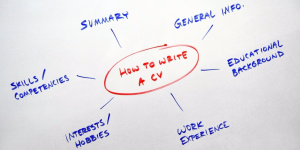
The standard opening for resumes of the past was an objective that told hiring managers what you were looking for. Resumes today are now moving past that. With hiring managers spending about 7 seconds on each resume, you need to do everything in your power to capture their attention. I’d say it’s high time to replace the “this is what I want” objective with a personal branding statement showing the value you bring.
As Job Coach Artie Fertig states, make sure to consider the following when creating your brand:
- Attributes: What are you passionate about?
- Value: What did you make, save or achieve for a company?
- Uniqueness: How does your approach differ from others with the same job title?
Promote Yourself
Once you have your personal branding statement, you need to start promoting yourself. Rather than handing out your resume everywhere you go, try using an inexpensive personal business card. Better yet, use LinkedIn! According to William Aruda, founder of Reach Personal Branding, LinkedIn is a one-stop shop when it comes to personal branding tools. It fulfills all the following roles:
- Agent
- 24/7 Billboard
- Professional Association
- Personal Website & Blog
- Portfolio
- Reference Check
- Teacher/Mentor
- Recruiter
- Sales Person
- Career Coach
- Contact Manager
- Research
-
Speaking of promotion
Building an online presence doesn’t need to be so scary. These 6 steps provide a great framework to start from:
- Take a regular baseline of what your current online presence looks like. If you are not finding much, that means you need to start posting regular content on your social sites. The more good quality information you post, the more often you will come up in search results when your name is being searched.
- Prove your communication skills through a blog.
- Visually represent your talent. Don’t be afraid to “toot your own horn,” by displaying accomplishments, awards or mentions online. If you like taking video, try posting content to YouTube.
- Host your own show. Any events that you host via Google Hangout will automatically post to your YouTube account. Not into hosting a chat? Try joining one and then sharing your commentary via other social channels.
- Spread it around. While I’m a big fan of becoming an expert at one social channel at a time, I also don’t think you should limit your content to one audience. Limiting yourself to one social channel means limiting yourself to the people who prefer it over other channels. Not everyone is going to like the current channel you are using. So once you are good at Facebook or Twitter or Google+…add another channel.
- Regularly share consistent quality. Once you have a following, it’s important to keep them coming back for fresh content. I typically ditch a blog that hasn’t posted something in the past month or two. Plus, every time you post…that’s another opportunity to be found.
- Don’t wait until you need it. Building a network after the fact is like watching Plan A fail and then realizing you don’t have a Plan B. Make sure to build your network and keep in touch. People are more likely to help others they have a relationship with.
What are you doing to improve your personal brand?



